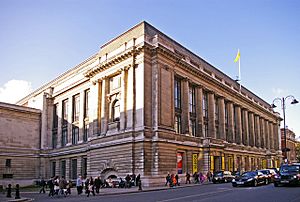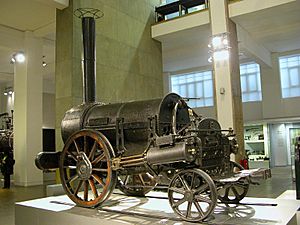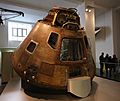Science Museum (London) facts for kids

The Science Museum
|
|
| Lua error in Module:Location_map at line 420: attempt to index field 'wikibase' (a nil value). | |
| Established | 1857 (separate status formalised 1909) |
|---|---|
| Location | Exhibition Road, Kensington & Chelsea London, SW7 United Kingdom |
| Visitors | 3,251,000 (2017) Ranked 6th nationally |
| Public transit access | |
| National Museum of Science and Industry | |
| National Media Museum · National Railway Museum (Shildon Locomotion Museum) · Science Museum (Dana Centre, Science Museum Swindon) | |
The Science Museum is a famous museum in London, England. It is one of three big museums located on Exhibition Road. This museum is a popular place for tourists and locals to visit. It is part of the National Museum of Science and Industry.
Since December 1, 2001, it has been free to enter the Science Museum. This is because the government helps pay for it. However, you might need to buy tickets for special temporary shows.
Contents
History of the Science Museum
How the Museum Started
The Science Museum began in 1857. A person named Bennet Woodcroft started it. He used items from the Royal Society of Arts and the Great Exhibition. Some of these items were machines. They became part of the Museum of Patents in 1858. Later, it was called the Patent Office Museum in 1863.
In 1883, these items moved to the South Kensington Museum. Two years later, in 1885, the science items were officially named the Science Museum. By 1893, the Science Museum had its own leader. The art items became the Art Museum, which is now the Victoria and Albert Museum.
Becoming an Independent Museum
Queen Victoria helped start a new building for the Art Museum. She said the museum should be named after her and her husband, Prince Albert. When the new building opened, only the art collections kept this name. The science collections were renamed again.
On June 26, 1909, the Science Museum officially became its own separate museum. The building you see today was designed by Sir Richard Allison. Parts of it opened to the public between 1919 and 1928. This building was called the East Block. It was meant to be the first part of a much bigger project, but that larger plan was never finished.
What You Can See: Museum Collections
Focus on Industry and Innovation
Even though it's called a science museum, it shows a lot about industry. It has real machines and working models from the Industrial Revolution. This was a time in the 1700s when many new machines were invented. The museum also covers Victorian engineering, the age of airplanes, and space travel from the 1900s.
Famous Items on Display
The Science Museum has over 300,000 items! Some very famous things you can see include:
- Stephenson's Rocket: A very old and important steam locomotive.
- Puffing Billy: The oldest surviving steam locomotive.
- The first jet engine.
- A model of DNA made by Francis Crick and James D. Watson.
- Early steam engines.
- A working example of Charles Babbage's Difference engine, an early computer.
- The first typewriter.
The museum also has many exhibits where you can touch and interact with things. There is an IMAX 3D Cinema. It shows science and nature documentaries in 3-D. The Wellcome Wing focuses on digital technology.
Medical History and Health
The museum also holds many items about medicine. These were collected by Henry Wellcome. On the fourth floor, there is an exhibit called "Glimpses of Medical History." It uses models and dioramas to show how medicine has changed over time.
The fifth floor has a gallery called "Science and the Art of Medicine." Here, you can see old medical tools and learn about practices from different countries. The collection includes many items about clinical medicine, biosciences, and public health. The museum is part of the London Museums of Health & Medicine.
Museum Library and Storage
The Science Museum has a special library. Until the 1960s, it was Britain's main library for science, medicine, and technology. It has old books, magazines, and handwritten papers. Scholars from all over the world use it.
Many items not currently on display are kept at Blythe House in West Kensington. This place also has a conservation laboratory to fix old items. There is also a photo studio and a quarantine area for new items.
Explore the Galleries
The Science Museum has many different areas called galleries. Some are always there, and some are temporary for special shows.
Power: The East Hall
The East Hall is often the first area visitors see. It goes up through three floors. On the ground floor, you will find many famous steam engines. These include the oldest surviving James Watt beam engine. They help tell the story of the British Industrial Revolution. High above, a large metal ring hangs from the ceiling. It has white LEDs that show patterns and messages typed by visitors.
Exploring Space
The Exploring Space gallery is all about history. It has rockets and exhibits that show the story of human space exploration. You can also learn about the benefits that space travel has brought us, especially in telecommunications.
Making the Modern World
Making the Modern World is a newer gallery. It displays some of the museum's most important objects. These include Stephenson's Rocket and an Apollo spacecraft. They are shown along a timeline that highlights human technological achievements.
Flight
The Flight gallery is an older, popular area on the third floor. It has several full-sized airplanes and helicopters. You can see Alcock and Brown's transatlantic Vickers Vimy from 1919. There are also Spitfire and Hurricane fighter planes. The gallery also shows many aero-engines and a part of a Boeing 747 airplane.
Launchpad: Hands-On Science
One of the most popular galleries is Launchpad. This is an interactive area where you can touch and try things. It was updated and reopened in November 2007. The new gallery has over 50 interactive exhibits. They help explain different ideas in physical science. Museum staff called "Explainers" are there to show how exhibits work. They also do live experiments and shows for schools and visitors.
Traveling Exhibitions
The Science Museum creates many exhibitions that travel around the world. For example, The Science Box series toured the UK and Europe in the 1990s. From 1995, The Science of Sport appeared in different ways around the world.
In 2005, the Science Museum worked with Fleming Media to create The Science of... exhibitions. These include The Science of Aliens, The Science of Spying, and The Science of Survival. In 2008, The Science of Survival exhibition opened. It let visitors imagine what the world might be like in 2050. It also showed how people might deal with climate change and energy shortages.
How to Get There: Location and Transport
The Science Museum is right next to the Natural History Museum. There used to be a public hallway connecting them, but it is now closed. The closest London Underground station is South Kensington. A special underground path connects the museums to the station.
The museum is on Exhibition Road to the east. To the south is Museum Lane and the Natural History Museum. Queen's Gate is at the back of the museum. To the north is Imperial College.
Transport Connections
| Service | Station/Stop | Lines/Routes served |
|---|---|---|
| London Buses |
Kensington Museums |
360 |
| Victoria & Albert Museum |
14, 74, 414, C1 | |
| London Underground |
South Kensington |
Images for kids
See also
 In Spanish: Museo de Ciencias de Londres para niños
In Spanish: Museo de Ciencias de Londres para niños







